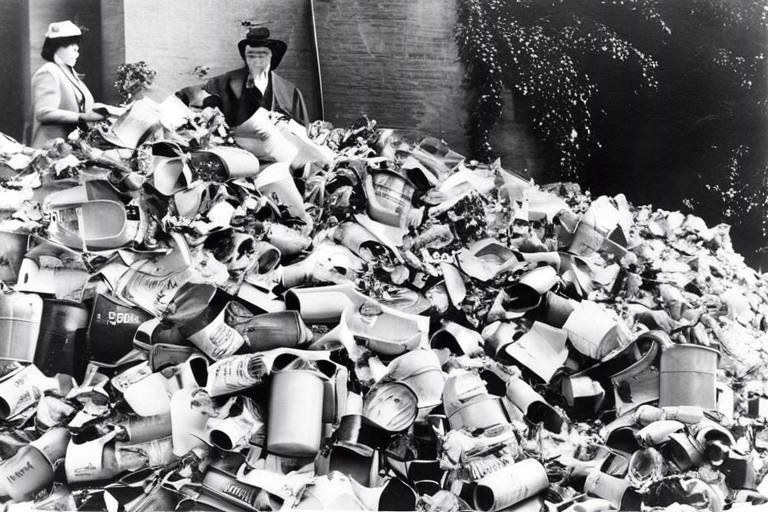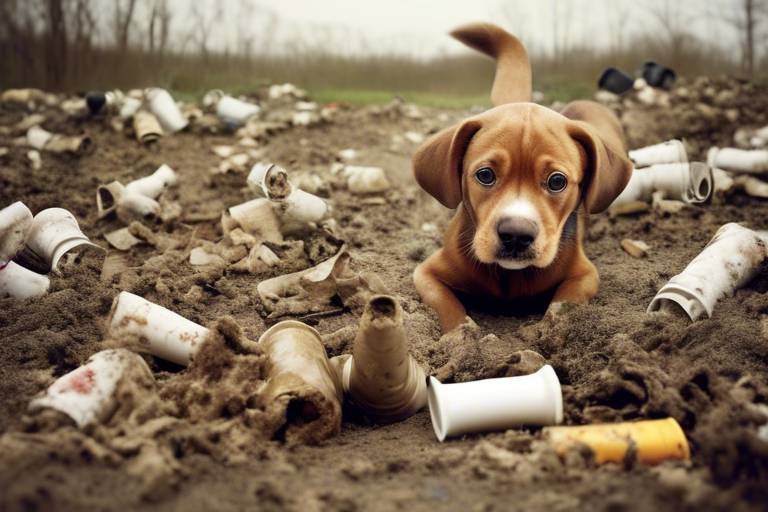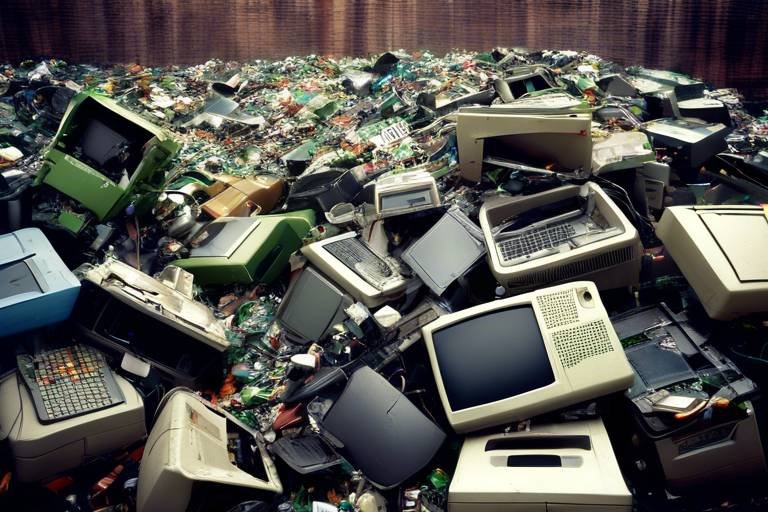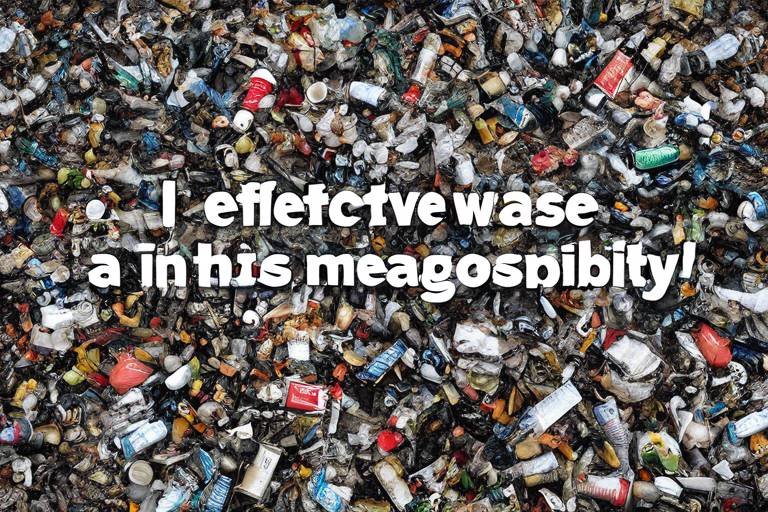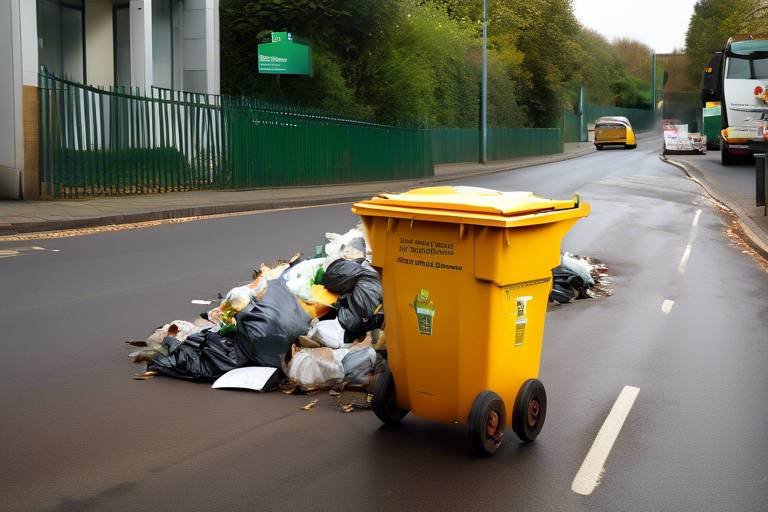How to Recycle Old Clothing?
In a world where fast fashion reigns supreme, the question of what to do with old clothing has become increasingly important. Recycling old clothing isn't just a trend; it's a necessity for promoting sustainability and reducing the overwhelming amount of textile waste that ends up in landfills. So, how do we go about it? Well, there are several effective methods, and each one presents a unique opportunity to not only declutter your closet but also contribute to a healthier planet.
One of the most straightforward ways to recycle old clothing is through donation. Many organizations and charities are eager to accept your gently used garments, ensuring they find a new home rather than languishing in a landfill. But donating is just the tip of the iceberg! Have you ever thought about upcycling your old threads? With a sprinkle of creativity, you can transform those discarded pieces into something entirely new and fabulous. Imagine turning a pair of worn-out jeans into a trendy tote bag or an old t-shirt into a stylish pillow cover. The possibilities are endless!
Another exciting avenue is participating in clothing swap events. These gatherings are not just fun; they’re a fantastic way to refresh your wardrobe without spending a dime! You bring your old clothes, swap them with friends or community members, and walk away with "new" items that you love. Plus, you’re helping to keep clothes in circulation, reducing the demand for new items. It's like a treasure hunt where everyone wins!
But let’s not forget about the innovative recycling programs offered by many brands today. Companies are increasingly recognizing their responsibility towards the environment and are setting up initiatives to recycle old clothing. By participating in these programs, you can ensure that your old clothes are processed responsibly and transformed into new materials, rather than being discarded. This not only conserves resources but also supports sustainable manufacturing processes.
For those who enjoy a hands-on approach, engaging in DIY recycling projects can be incredibly rewarding. Whether you’re a seasoned crafter or a beginner, there are plenty of projects you can tackle at home. From creating unique fashion items to home decor, DIY projects allow you to express your personality while giving your old clothes a second life. It’s a win-win situation where your creativity shines, and the environment benefits!
Now, you might be wondering, what are the actual benefits of recycling clothing? Well, recycling not only helps in conserving natural resources but also significantly reduces pollution and greenhouse gas emissions. Moreover, it fosters community spirit and support, as many donated clothes go to those in need. It’s about creating a cycle of giving that benefits everyone involved.
However, it’s essential to acknowledge that clothing recycling isn’t without its challenges. Issues like contamination of recyclable materials and a general lack of consumer awareness can hinder the recycling process. But fear not! By educating ourselves and our communities about proper recycling practices, we can overcome these obstacles and make a significant impact.
In conclusion, recycling old clothing is a multifaceted approach that not only helps the environment but also enriches our lives. Whether you choose to donate, upcycle, swap, or participate in recycling programs, every action counts. So, let’s roll up our sleeves and get started on this journey toward a more sustainable future!
- What types of clothing can I recycle? Most clothing items are recyclable, including shirts, pants, dresses, and outerwear. However, items that are heavily stained or damaged may not be accepted.
- How do I find a clothing donation center near me? You can search online for local charities or organizations that accept clothing donations. Many have websites with drop-off locations and guidelines.
- What is upcycling, and how can I start? Upcycling is the process of transforming old items into new products. You can start by looking for tutorials online for simple projects that match your skill level.
- Are clothing swap events safe? Yes, as long as proper hygiene and safety measures are followed. Make sure to wash your clothes before bringing them to the swap.
- How can I educate others about clothing recycling? Share your knowledge through social media, organize community events, or simply talk to friends and family about the importance of recycling clothing.

Understanding Textile Waste
Textile waste is an alarming environmental issue that often flies under the radar. Did you know that every year, millions of tons of clothing end up in landfills? It's like a never-ending cycle of consumption and disposal, where our love for fashion leads to a mountain of discarded garments. Just imagine this: a single person can throw away around 81 pounds of clothing annually. That’s equivalent to the weight of a small child! This staggering statistic highlights the urgent need to address our textile waste problem.
When we think about waste, we often picture plastic bottles or food scraps, but textiles are just as harmful. Once clothing is tossed aside, it can take anywhere from 20 to 200 years to decompose, depending on the materials used. While natural fibers like cotton may break down eventually, synthetic fibers like polyester can linger in the environment indefinitely, contributing to soil and water pollution. The impact is not just limited to landfills; the production of new clothing also consumes vast amounts of resources, including water, energy, and raw materials.
So, why is recycling clothing so crucial? First and foremost, recycling helps to reduce the demand for new textiles. By giving old clothes a second life, we can significantly decrease the environmental footprint associated with the production of new garments. Furthermore, recycling clothing conserves valuable resources and minimizes pollution. Here are a few compelling reasons to consider:
- Conservation of Resources: Recycling textiles reduces the need for virgin materials, which means less water and energy consumption.
- Reduction of Landfill Waste: By recycling, we can divert significant amounts of waste from landfills, prolonging their lifespan.
- Lower Carbon Footprint: The recycling process typically emits fewer greenhouse gases compared to producing new clothing.
Moreover, the fashion industry is one of the largest polluters in the world, and understanding the implications of textile waste is vital for fostering a more sustainable future. By becoming more aware of our consumption habits and the lifecycle of our clothing, we can make informed decisions that positively impact our environment. Whether it’s through recycling, donating, or upcycling, every small action contributes to a larger movement toward sustainability.
In summary, textile waste is not just an issue for the eco-conscious; it’s a global crisis that affects us all. By understanding the implications of our clothing choices and the importance of recycling, we can work together to create a cleaner, greener world for future generations. So, next time you’re about to toss that old shirt, think twice! Your small change can lead to a significant impact.

Donation Options
Donating old clothing is not just a way to declutter your closet; it's a powerful act of kindness that can significantly impact those in need. Think about it: every time you donate a shirt or a pair of shoes, you’re not just getting rid of items that no longer serve you; you’re providing someone else with the opportunity to wear something new, or perhaps something they couldn't afford otherwise. Isn’t that a beautiful cycle of giving?
There are numerous organizations and charities that accept clothing donations, making it easier than ever to find a suitable place for your items. Whether you're looking to support local shelters, international charities, or environmental initiatives, there's a donation option for everyone. Here are some popular organizations you might consider:
- Goodwill: A well-known nonprofit that accepts a wide range of clothing and household items, Goodwill uses the proceeds from sales to fund job training programs.
- The Salvation Army: This organization not only provides clothing donations to those in need but also uses the funds generated from thrift store sales to support rehabilitation programs.
- Dress for Success: Focused on empowering women, this charity provides professional attire to help women succeed in the workplace.
- Planet Aid: This organization collects clothing for recycling and resale, promoting environmental sustainability while helping communities.
But the impact of your donation goes beyond just the immediate benefit to individuals. When you donate, you’re also helping to reduce textile waste that contributes to the ever-growing problem of landfills. Did you know that approximately 92 million tons of textile waste is generated each year? That's like tossing a truckload of clothes into a landfill every second! By donating your clothing, you’re playing a crucial role in mitigating this environmental crisis.
Before you donate, it’s important to ensure your items are in good condition. Most organizations have guidelines on what they will accept, so be sure to check their websites or call ahead. Items that are stained, torn, or heavily worn may not be suitable for donation and could end up in the trash instead of being reused. A simple rule of thumb is: if you wouldn’t wear it, it’s probably best not to donate it.
In addition to traditional charities, consider local community centers or shelters that might have specific needs for clothing donations. Sometimes, schools or churches also run clothing drives, especially during the colder months. These grassroots efforts often have a direct and immediate impact on your local community.
Finally, don't forget about the option of hosting a clothing drive. Gather your friends, family, or coworkers to collect items that can be donated collectively. This not only helps you declutter but also raises awareness about the importance of recycling clothing and supporting those in need. Plus, it can be a fun community activity!
In summary, donating old clothing is a simple yet effective way to make a positive difference. By choosing to give your garments a second life, you’re not just helping someone in need; you’re also contributing to a more sustainable future. So, the next time you clean out your closet, remember the power of donation!

Upcycling Ideas
Upcycling is like giving your old clothes a fresh lease on life, and it’s a fantastic way to express your creativity while being kind to the planet. Instead of tossing those worn-out jeans or that oversized sweater into the landfill, why not transform them into something new and exciting? Upcycling not only reduces waste but also allows you to create unique items that reflect your personal style. Think of it as turning yesterday’s fashion into today’s treasure!
One popular upcycling idea is to turn old t-shirts into trendy tote bags. It’s super simple! Just cut off the sleeves, turn the shirt inside out, and sew the bottom shut. Voila! You have a stylish bag perfect for groceries or a day out at the beach. This method is not only practical but also a fun project that you can do with friends or family. Imagine hosting a little upcycling party where everyone brings their old shirts and leaves with a new bag!
Another creative approach is to transform old jeans into a chic pair of shorts or a fashionable denim skirt. Just grab a pair of scissors and a sewing machine, and you can easily customize the fit to your liking. You can even add embellishments like patches or embroidery to give your new garment a personal touch. This not only breathes new life into your old clothes but also allows you to showcase your unique fashion sense.
For those who love home decor, consider turning old sweaters into cozy pillow covers. Simply cut the sweater to fit your pillow form, sew it up, and you’ll have a warm and inviting addition to your living room. It’s an excellent way to repurpose garments that may have lost their original charm but still have plenty of life left in them.
If you’re feeling particularly crafty, you might want to try your hand at making a quilt from old clothing. This project can be a beautiful way to preserve memories associated with certain garments. Imagine snuggling under a quilt made from your favorite concert t-shirts or your children’s outgrown clothes. Not only does it serve as a functional item, but it also becomes a cherished keepsake.
Here are a few more quick upcycling ideas to spark your imagination:
- Turn a button-up shirt into a stylish summer dress.
- Repurpose a scarf into a headband or hair accessory.
- Create a fabric necklace from scraps of old clothing.
- Make a pet bed using old blankets or sweaters.
Upcycling is a fantastic way to engage with your creativity while doing your part for the environment. Not only do you get to enjoy the satisfaction of creating something new, but you also contribute to reducing textile waste. So, the next time you find yourself with a pile of old clothes, remember that they can be transformed into something extraordinary!
Q: What materials are best for upcycling?
A: Almost any fabric can be upcycled! T-shirts, jeans, sweaters, and even curtains can be repurposed into something new. Just ensure the material is clean and in good condition.
Q: Do I need special skills to start upcycling?
A: Not at all! Many upcycling projects are beginner-friendly. Start with simple designs, and as you gain confidence, you can tackle more complex projects.
Q: Where can I find inspiration for upcycling?
A: There are countless resources online, including blogs, social media platforms like Pinterest and Instagram, and DIY websites that showcase upcycling projects. You can also join local crafting groups for ideas and support!

Clothing Swap Events
Have you ever thought about how much clothing we accumulate over the years? It’s like a never-ending cycle of buying, wearing, and then tossing aside garments that no longer spark joy. Instead of letting those clothes gather dust in the back of your closet, why not consider a clothing swap event? These gatherings are not just a fun way to refresh your wardrobe; they also promote sustainability and community engagement. Imagine trading that old sweater you never wear for a trendy dress that fits you perfectly. Sounds like a win-win, right?
So, how do clothing swap events work? Typically, participants bring their gently used clothing items to a designated location. Once there, everyone lays out their items, and the swapping begins! It’s a delightful treasure hunt where you can discover unique pieces you might not find in stores. Plus, you’re giving your clothes a second life while helping others do the same. It’s like a community thrift shop, but with the thrill of a personal touch.
Organizing a clothing swap event in your community can be incredibly rewarding. Here’s a quick guide to get you started:
- Choose a Location: Find a community center, park, or even your backyard that can accommodate your guests.
- Set a Date: Pick a day and time that works for most people. Weekends are usually a hit!
- Spread the Word: Use social media, flyers, and word of mouth to invite friends and family. The more, the merrier!
- Establish Guidelines: Decide on rules, such as the number of items each person can bring and any restrictions on clothing types.
By following these simple steps, you can create a vibrant atmosphere where everyone leaves with something new (to them) and the satisfaction of knowing they’ve recycled their clothes in a meaningful way. Not only does this help reduce textile waste, but it also fosters a sense of community as people come together to share, swap, and socialize.
In addition to the environmental benefits, clothing swap events can also be a great way to meet new friends. Everyone loves a good chat about fashion, and who knows? You might find a fellow fashionista who shares your style! Plus, the excitement of finding hidden gems among the swapped items can lead to some memorable stories and connections.
So, if you’re looking for a fun and eco-friendly way to refresh your wardrobe, consider hosting or attending a clothing swap event. It’s a fantastic opportunity to declutter your closet while embracing a more sustainable lifestyle. And remember, every little bit helps when it comes to reducing textile waste!
Q: What types of clothing can I bring to a clothing swap?
A: Generally, you can bring any gently used clothing items, including tops, bottoms, dresses, shoes, and accessories. Just make sure they are clean and in good condition!
Q: Do I have to bring items to participate?
A: While most events encourage participants to bring items to swap, some may allow you to simply come and browse. Check the specific guidelines of the event you’re attending.
Q: What happens to leftover clothes after the swap?
A: Many organizers choose to donate any leftover items to local charities or thrift stores, ensuring that the clothing continues to be reused and doesn't end up in landfills.
Q: Can I organize a clothing swap event for a specific group?
A: Absolutely! Whether it’s for friends, coworkers, or a community group, clothing swaps can be tailored to any audience. Just make sure to communicate the details clearly!

Recycling Programs
In today's world, where sustainability is more than just a buzzword, clothing recycling programs are stepping up to the plate, offering a lifeline to our planet. These programs not only help reduce the amount of textile waste that ends up in landfills but also promote a culture of reuse and responsible consumption. Imagine a world where your old jeans could be transformed into new fabrics or even insulation for homes! That’s the magic of recycling programs.
Many well-known brands and organizations have recognized the need for sustainable practices and have initiated their own recycling programs. For instance, companies like H&M and Patagonia have set up systems where customers can drop off their used clothing in-store. These garments are then sorted—some are resold, while others are recycled into new materials. This not only diverts waste from landfills but also encourages consumers to think twice before tossing their clothes into the trash.
Additionally, there are non-profit organizations such as Goodwill and The Salvation Army that accept donations of old clothing. These organizations often have recycling programs in place to ensure that even items that cannot be sold are processed responsibly. By donating your clothes, you are not just decluttering your closet; you are contributing to a larger movement aimed at reducing waste and supporting community initiatives.
Moreover, some innovative programs are taking recycling a step further by focusing on the circular economy. Brands like Levi's have launched initiatives where they collect worn-out jeans and turn them into new products, creating a cycle of sustainability. This not only reduces the need for new raw materials but also minimizes the environmental impact associated with textile production.
Here’s a quick overview of some notable recycling programs:
| Brand/Organization | Recycling Program | How It Works |
|---|---|---|
| H&M | Garment Collecting Initiative | Drop off used clothing in-store for recycling or reuse. |
| Patagonia | Worn Wear | Trade in old Patagonia gear for credit towards new purchases. |
| Levi's | SecondHand | Collects old jeans to recycle into new products. |
| Goodwill | Donation Centers | Accepts clothing donations and recycles unsellable items. |
These programs highlight the importance of taking action at both the individual and corporate levels. By participating in these initiatives, you not only help reduce waste but also support ethical practices in the fashion industry. So, next time you’re considering tossing that old t-shirt, think about the potential it has for a second life through these amazing recycling programs!
What types of clothing can be recycled?
Most clothing items can be recycled, but it's best to check with the specific program for their guidelines. Generally, clean and dry garments, shoes, and accessories are accepted.
Is there a cost associated with recycling clothing?
Most clothing recycling programs are free, especially those run by non-profits or community organizations. However, some brands may offer incentives or discounts for participating in their programs.
Can I recycle damaged or stained clothing?
Yes, many programs accept damaged or stained items, as they can often be repurposed or recycled into new materials.
How can I find a recycling program near me?
You can search online for local recycling programs or check with your favorite clothing brands to see if they have any initiatives in your area.

DIY Recycling Projects
Engaging in is not only a fantastic way to breathe new life into your old clothing, but it also allows you to express your creativity and reduce waste at the same time. Imagine taking that old pair of jeans that no longer fits and transforming them into a trendy tote bag or a stylish pair of shorts! The beauty of DIY projects lies in their ability to turn something considered "waste" into a unique piece that tells a story. So, let’s dive into some creative ideas that you can try at home!
One popular project is creating tote bags from old T-shirts. It's incredibly simple! Just cut off the sleeves and neckline, then tie the bottom shut. You can even add some embellishments like fabric paint or patches to personalize your new bag. This project not only helps you recycle but also gives you a functional item that you can use for grocery shopping or beach outings.
Another exciting idea is to make upcycled fabric coasters. Grab those old shirts or any leftover fabric scraps, cut them into circles or squares, and sew them together. Not only do these coasters protect your surfaces, but they also add a pop of color to your home décor. Plus, you can coordinate them with your existing color scheme, making them a perfect match for your living space.
For those who love a bit of sewing, consider creating a patchwork quilt from various pieces of fabric. This project can be a labor of love, but the result is a cozy quilt that not only warms you up but also serves as a conversation starter. Each square can represent a memory or a moment, making it a sentimental piece in your home.
Don’t forget about decorative pillows! Old clothing can easily be transformed into beautiful pillow covers. Simply cut the fabric to size, sew it up, and stuff it with some old cushions or fabric scraps. You can mix and match patterns and colors for a fun, eclectic look that showcases your personal style.
Lastly, if you’re feeling adventurous, how about trying your hand at fabric jewelry? You can create stunning necklaces or bracelets using strips of fabric from old clothes. Braid or knot the strips together, and you’ll have a unique accessory that’s sure to catch everyone’s eye. This not only recycles your clothing but also gives you a chance to wear your creativity!
In summary, DIY recycling projects are a wonderful way to reduce textile waste and create something beautiful and functional. Whether you choose to make tote bags, coasters, quilts, pillows, or jewelry, the possibilities are endless. So, gather your old clothes and let your imagination run wild! You’ll be amazed at what you can create with a little effort and creativity.
Q: What types of clothing are best for DIY projects?
A: Almost any type of clothing can be used for DIY projects! However, items like T-shirts, jeans, and cotton fabrics are particularly versatile and easy to work with.
Q: Do I need special tools for these projects?
A: Basic sewing supplies such as scissors, needles, and thread are usually sufficient. However, a sewing machine can speed up the process and give a more professional finish.
Q: Can I sell the items I create?
A: Absolutely! If you create unique and high-quality items, you can sell them at local craft fairs, online marketplaces, or through social media.
Q: How can I find more ideas for DIY recycling projects?
A: There are countless resources available online, including blogs, YouTube tutorials, and Pinterest boards dedicated to DIY recycling. A quick search can yield a treasure trove of inspiration!

Benefits of Recycling Clothing
Recycling clothing is not just a trend; it’s a powerful movement that benefits both the environment and society at large. Imagine a world where every piece of clothing is given a second chance instead of ending up in a landfill. By recycling your old garments, you contribute to a cycle that promotes sustainability and reduces waste. But what exactly are the benefits of recycling clothing? Let’s dive in!
First and foremost, recycling clothing significantly reduces landfill waste. Did you know that the fashion industry is one of the largest contributors to landfill waste? According to estimates, around 92 million tons of textile waste are generated globally each year. By recycling, we can divert a substantial portion of this waste away from landfills, ultimately leading to a cleaner environment. Each piece of clothing recycled is a step towards a more sustainable future.
Moreover, recycling clothing helps conserve natural resources. The production of new clothing requires a vast amount of water, energy, and raw materials. For instance, it takes about 2,700 liters of water to produce a single cotton t-shirt. When we recycle clothing, we reduce the need for new materials, which in turn minimizes the consumption of these precious resources. This is a perfect example of how small actions can lead to significant environmental impacts.
Another key benefit is the positive impact on local communities. Many organizations that accept clothing donations use the proceeds to support various community programs. This means that your old clothes can help fund education, health services, and job training for those in need. So, when you recycle your clothing, you are not just helping the planet; you are also making a difference in the lives of others.
Additionally, recycling clothing can foster a sense of community and creativity. Engaging in clothing swaps or upcycling projects allows individuals to connect with others who share similar values. It’s not just about getting rid of unwanted items; it’s about creating a community that values sustainability and creativity. Think of it as a modern-day barter system where everyone benefits!
To illustrate the benefits further, here’s a quick comparison of the environmental impacts of recycling clothing versus throwing it away:
| Action | Environmental Impact |
|---|---|
| Recycling Clothing | Reduces landfill waste, conserves natural resources, lowers carbon footprint |
| Throwing Clothing Away | Increases landfill waste, contributes to pollution, depletes resources for new production |
In conclusion, the benefits of recycling clothing are multifaceted, touching on environmental conservation, community support, and personal creativity. By choosing to recycle, you not only help reduce waste but also promote a healthier planet and a more connected community. So next time you consider tossing that old shirt, think about the impact your recycling efforts can have!
Q: What types of clothing can be recycled?
A: Most clothing items can be recycled, including shirts, pants, dresses, and even accessories like belts and bags. However, items that are heavily soiled or damaged may not be accepted.
Q: Where can I recycle my old clothes?
A: You can recycle your old clothes through local charities, thrift stores, or specialized recycling programs. Many retailers also offer take-back programs for clothing.
Q: Can I make money from recycling my clothes?
A: Yes! Some thrift stores and consignment shops will buy your gently used clothing. Additionally, clothing swap events can be a fun way to exchange items without spending money.
Q: What happens to the clothes I donate?
A: Donated clothes may be resold in thrift stores, given to those in need, or recycled into new materials. The specific process depends on the organization you donate to.

Challenges in Clothing Recycling
Recycling clothing is not as straightforward as it might seem. While the idea of giving old garments a new life is appealing, several challenges hinder the effectiveness of clothing recycling efforts. One of the most significant issues is contamination. When textiles are mixed with non-recyclable materials, it complicates the recycling process. For instance, if a donation bin is filled with clothing that includes items like shoes, bags, or household textiles, it can lead to entire batches being deemed unsuitable for recycling. This not only wastes resources but also increases the burden on recycling facilities.
Another challenge is the lack of consumer awareness. Many people are simply unaware of how to recycle their clothing properly. They may think that tossing items into a donation bin is sufficient, but they might not realize that certain items are not accepted or that they need to be clean and in good condition. This lack of understanding can lead to frustration for both consumers and recycling organizations.
Additionally, the quantity of clothing produced plays a crucial role in the recycling dilemma. The fashion industry is notorious for its fast fashion model, which encourages consumers to buy more than they need and dispose of items quickly. As a result, the sheer volume of clothing waste can overwhelm existing recycling systems. According to some estimates, around 92 million tons of textile waste is generated globally each year, and without significant changes in consumer behavior and industry practices, recycling efforts may struggle to keep pace.
Moreover, the economic viability of clothing recycling is another hurdle. Many recycling programs rely on funding or donations, and without sufficient financial support, they may not be able to operate effectively. Furthermore, the costs associated with sorting and processing textiles can be high, which may deter businesses from investing in recycling initiatives.
To tackle these challenges, we need to adopt a collective approach. This can involve raising awareness about proper recycling practices, encouraging consumers to be more mindful of their purchasing habits, and supporting brands that prioritize sustainability. Education plays a pivotal role in this process; by informing individuals about the importance of recycling and the impact of their choices, we can help foster a culture that values sustainability.
In conclusion, while the challenges in clothing recycling are significant, they are not insurmountable. By addressing contamination, enhancing consumer awareness, managing the volume of waste, and ensuring economic viability, we can pave the way for a more sustainable future. Together, we can turn these challenges into opportunities for innovation and change.
- What types of clothing can be recycled? Most clothing made from natural or synthetic fibers can be recycled, but items should be clean and free from contaminants.
- How can I find a local recycling program? Many local charities and organizations have recycling programs. A quick online search or visit to your community center can provide information.
- What should I do if my clothing is damaged? If clothing is damaged beyond repair, consider repurposing it or donating it to organizations that specialize in fabric recycling.
- Can I recycle clothing that I bought from fast fashion brands? Yes, you can recycle fast fashion clothing. The focus should be on reducing waste rather than the brand of the clothing.
Frequently Asked Questions
- What is textile waste and why is it a problem?
Textile waste refers to discarded clothing and fabric materials that end up in landfills. This is a significant problem because it contributes to pollution, takes up space in landfills, and can take years to decompose. Recycling clothing helps reduce this waste and its environmental impact.
- How can I donate my old clothes?
Donating old clothes is easy! You can take them to local charities, thrift stores, or community organizations. Many places have drop-off bins, and some even offer pick-up services. Just make sure your items are clean and in good condition!
- What is upcycling, and how can I do it?
Upcycling is the creative process of transforming old clothing into new, useful items. You can turn an old t-shirt into a tote bag, or repurpose jeans into stylish shorts. The possibilities are endless, and it’s a fun way to express your creativity while reducing waste!
- What are clothing swap events?
Clothing swap events are gatherings where people exchange their old clothes with others. It’s a fun and social way to refresh your wardrobe without spending money. You simply bring items you no longer want and trade them for something new to you!
- Are there recycling programs for old clothing?
Yes! Many brands and organizations have clothing recycling programs. They accept old garments, sort them, and recycle them into new materials. Some even offer incentives, like discounts on future purchases, for participating in their recycling initiatives.
- Can I do DIY projects with my old clothes?
Absolutely! DIY projects are a fantastic way to give new life to old clothing. You can make everything from pillow covers to pet toys. There are plenty of online tutorials to guide you through various projects, making it easy and fun!
- What are the benefits of recycling clothing?
Recycling clothing has numerous benefits. It conserves resources, reduces landfill waste, and supports community initiatives. Plus, it can save you money and help you discover unique, second-hand items that have character and history.
- What challenges does clothing recycling face?
Clothing recycling faces several challenges, such as contamination of recyclable materials and a lack of consumer awareness. To overcome these issues, it's important to educate people about proper recycling practices and encourage participation in recycling programs.


